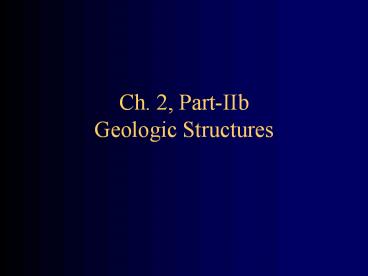Ch.%202,%20Part-IIb%20Geologic%20Structures PowerPoint PPT Presentation
Title: Ch.%202,%20Part-IIb%20Geologic%20Structures
1
Ch. 2, Part-IIbGeologic Structures
2
Geologic Structures
- Generally planar features within, cross-cutting,
or disrupting the rock materials/strata (layers) - Important in environmental geology as
- Discontinuities
- Topography/landforms
- Indicators of tectonics
- Implications for natural hazards
- Structural integrity
- Planes/zones of weakness
- Preferrentialpathways for fluid/contaminants
3
Types of Geologic Structures
- Stratification (Layers Layering)
- Folding/Tilting
- Faulting
- Other Structures
- fractures
- joints
- crosscutting from forceful injections
(dikes/sills)
4
Layering/Strata
5
- Tilted Layers
- Indicative of forces causing horizontal layers to
be disrupted (tilted)
6
Significance of Layering/Tilting
- Basic geologic structure
- Planar reference boundaries that define strata
(boundaries between/within rock materials) - Implications for landforms/topography?
- Potential pathways
7
(No Transcript)
8
FOLDS
Topography similar to Appalachians
Indicative of directed (compressional) forces
(past or present)
9
(No Transcript)
10
(No Transcript)
11
Dip Slip Faulting
Expressions of directed forces as
broken/displaced strata
Strike Slip Faulting
12
(No Transcript)
13
Significance of Fault Folds
- Areas of broken and/or disrupted crust
- Usually associated with topographic features
- Usually results in exposure of different types of
rock materials at surface - Indicative of past and/or present forces
- Potential for environmental hazard?
- Often associated with natural resources
(minerals, petroleum, etc.) - Effects on fluid pathways (as preferential
pathways or barriers)
14
Other Structures
- Fractures
- Joints
- Crosscutting material from forceful injections
- Dikes (cross-cuts layering)
- Sills (parallel to layering)
15
Cross-Cutting RelationshipsDikes Sills
16
(No Transcript)
17
(No Transcript)
18
Jointing
19
Some Environmental Implications of Geologic
Structures
- Layering or Foliation
20
(No Transcript)
21
(No Transcript)
22
(No Transcript)
23
Summary / Review
- Building blocks of rock materials atoms,
molecules, minerals, rocks/rock materials - Most abundant minerals are silicates
- Basic building block is the silica tetrahedra
- Rock properties determined by properties of
component materials (minerals) - Three main classes of rocks
- Igneous Formed from molten material
- Sedimentary Clastic, chemical, organic,
combinations - Metamorphic foliated, non-foliated
24
Summary / Review
- Rock type provides various types of information
- Environment/setting in which they were formed
- Tectonic implications
- Implications for natural hazards
- Physical, chemical properties
- Etc.
- Geologic Structures
- Layering, tilting
- Folding
- Faulting
- Other types (fractures, jointing, cross-cutting
features) - Implications/significance of geologic structures
25
Chapter (Section) Objectives
- Review of some of the important mineral and rock
types and their environmental significance - Relationships between atoms, minerals, rocks,
rock materials - Basic silicate building block(s)
- Properties of rocks minerals
- Basic rock types, basis for classification, types
of information they tell us - Appreciation/significance of geologic structures
- Layering
- Folds
- Faults
- Other structures (joints, dikes/sills, etc.)
26
(No Transcript)

